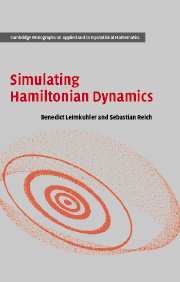Book contents
- Frontmatter
- Contents
- Preface
- Acknowledgements
- 1 Introduction
- 2 Numerical methods
- 3 Hamiltonian mechanics
- 4 Geometric integrators
- 5 The modified equations
- 6 Higher-order methods
- 7 Constrained mechanical systems
- 8 Rigid body dynamics
- 9 Adaptive geometric integrators
- 10 Highly oscillatory problems
- 11 Molecular dynamics
- 12 Hamiltonian PDEs
- References
- Index
5 - The modified equations
Published online by Cambridge University Press: 04 December 2009
- Frontmatter
- Contents
- Preface
- Acknowledgements
- 1 Introduction
- 2 Numerical methods
- 3 Hamiltonian mechanics
- 4 Geometric integrators
- 5 The modified equations
- 6 Higher-order methods
- 7 Constrained mechanical systems
- 8 Rigid body dynamics
- 9 Adaptive geometric integrators
- 10 Highly oscillatory problems
- 11 Molecular dynamics
- 12 Hamiltonian PDEs
- References
- Index
Summary
We have seen in the previous chapter that integrators preserving symplectic structure and/or first integrals can often be constructed in a straightforward way. In this chapter, we consider the properties of those methods and the implications for long-term simulations.
The traditional approach of numerical analysis generally assumes that the purpose of simulation is the faithful reproduction of a particular solution or trajectory, but individual trajectories typically are not of primary interest in most modern, scientific research; rather, the scientist typically treats the trajectory as a particular realization of a fundamentally stochastic evolution modelling in some way the myriad undetermined perturbations present in a “real-world” environment. It was the important discovery of Lorenz that differential equations can exhibit a chaotic solution behavior that includes an essentially stochastic or “random” component. The scientist views the model being analyzed as representative of a class of nearby models based on parameters which are typically only empirically (and approximately) determined. Furthermore, exact initial conditions are also typically not available. Some classical examples of such a scenario are molecular dynamics and numerical weather prediction.
It is now apparent that most modern large-scale simulations are conducted with timesteps and time intervals such that the numerical solution cannot be thought of as close to any particular model solution. The purpose of wedding the development of integrators to the standard axiomatic principle of timestepping – that one is attempting to approximate a particular trajectory – is thus called into question. Although high accuracy often is not needed in nonlinear dynamics computations, we must recognize certain important constraints imposed by the laws of nature.
- Type
- Chapter
- Information
- Simulating Hamiltonian Dynamics , pp. 105 - 141Publisher: Cambridge University PressPrint publication year: 2005



